Important Point
Why We Need a Refrigeration
Refrigeration, including air conditioning, is essential for life and will continue to expand worldwide. Its impact on the environment is huge, even though refrigeration technologies can be part of the solution to reduce global warming (new sources of energy, heat pumps).
However, the reduction of CO2 emissions and fluoride gas emissions are challenging to be addressed on an ongoing basis. Many attempts have already been made.
What Is Refrigeration System?
Refrigeration systems are an essential process in industry and home applications as they perform cooling or maintain room temperature at a desired value. A cycle of refrigeration consists of heat exchange, compression and expansion with a refrigerant flowing through the units within the cycle.
Refrigeration System
Worldwide alerts about global warming have led to a growing interest in new HVAC (heating, ventilation, and air conditioning) technologies with little environmental impact.
One way to achieve high heat transfer rates in compact heat exchangers is by using the mini chan technique. When considering this effect, both indirect effects due to energy consumption and carbon dioxide emissions as a result of the power generation process and direct effects due to the leakage of refrigerant must be taken into account.
In addition to high heat flux applications, as a suitable alternative to reduce the charge of refrigerants, reduce the problems of the release of potentially hazardous liquids into the atmosphere and allow the use of natural liquids such as hydrocarbons and carbon dioxide. Minichannels are seen in.
Also, Read: What Is a Comparator | Types of Comparators
Refrigeration Cycle
Heat flows in the direction of decreasing temperature, that is, from high temperature to the following regions. Transfer of heat from low temperature to high temperature requires refrigerator and/or heat pump.
Refrigerators and heat pumps are essentially the same equipment; They are just different purposes in themselves. The performance of refrigerators and heat pumps is expressed in terms of coefficients.
Refrigeration and Air-Conditioning
Looking at environmental protection, including standardization, terminology, mechanical safety, testing and rating equipment methods, sound levels, refrigerants, and refrigeration lubricant chemistry in the field of refrigeration and air conditioning. Refrigeration systems that are not covered by other ISO technical committees.
Scope includes factory-assembled air-conditioners (cooling), heat pumps, dehumidifiers, refrigerants, and refrigerant recycling and recycling equipment as well as other equipment, components and equipment such as humidifiers, ventilation equipment and air-conditioning and automatic controls.
Useful Article for You
Principle of Refrigeration
In the process of refrigeration, the available heat, along with the system of retaining at low temperatures, is continuously removed and transferred to the surrounding temperature, which is at higher temperatures.
The basic system of refrigeration is shown in fig. 6.1 in which T1 and T2 are the maximum and minimum temperature bodies, respectively; R is the refrigerator; Q1 is the heat supplied to the hot body, and Q2 is the heat extracted from the body with low temperature, And WR is the work required to produce low temperatures.
According to the second law of thermodynamics (Clausius theorem), it is only possible to remove heat from low temperatures to supply heat at high temperatures by supplying external work to the system under operation.
Therefore, a refrigerator needs external power to continuously remove heat from the cabinet to maintain a low temperature from the surroundings.
Difference Between Air Conditioning and Refrigeration
In energy, the system supplies thermal energy from one place to a high-temperature site, whereas in air conditioning, thermal energy is taken from the air to cool the air.
An AC consists of an indoor and exhaust unit connected to a pipe. The air is heated, compressed, condensed, and then dried, then the liquid gas is evaporated and cooled with the help of a condenser to give the cold air that we experience.
It can be seen flowing from a high-temperature location to a low-temperature bearing site. The use of heat pumps and refrigerator stores can be seen in all these types of appliances.
Air Conditioning Vs Refrigeration
| Sr.No. | Air Conditioning | Refrigeration |
| 1 | Thermal energy is taken away from the place to keep the air cooler. | Thermal energy is transferred from one place to a place of higher temperature. |
| 2 | It is a type of refrigeration used to cool a large area. | It helps to flow thermal energy against the natural flow of heat. |
| 3 | It deals with maintaining the temperature of a certain volume of air and also maintaining purity and humidity. | It deals only with regulating the temperature of the air, such as cooling and freezing of products. |
| 4 | The compressor and condenser are a separate unit from the evaporator. | The appliance has a condenser, compressor, and evaporator in one unit. |
| 5 | The mechanism is supplied with gas from the tubes. | Internal chemicals and even air is supplied from the environment. |
| 6 | Cold air is pushed away from the unit. | Cold air is kept inside the unit. |
Also, Read: How Do Aircraft Brakes Work | How Aircraft Brakes Work | Brake Design | Aircraft Brakes
Refrigeration Coolant
There is virtually no coolant that will fully satisfy the requirements: the cheapest coolant – water. But since the cold temperature is high (0 ° C), water is used only at positive temperatures in air conditioning systems and processes.
Aqueous solutions of NaCl, CaCl2, and MgCl2 – pickles are commonly used in negative temperatures. Thermophysical properties, including freezing temperature, depending on the concentration of salt in the brine.
All have a so-called brine eutectic concentration, in which the solution has a very low freezing point. The freezing temperature of the solution increases with further increase in salt concentration.
On further cooling, the solution reaches a point at the Krogogradnoy point at which it freezes completely.
Also, Read: Difference Between Orthogonal and Oblique Cutting | Orthogonal Machining
Units of Refrigeration
The capacity of a refrigeration system is expressed in terms of tons of refrigeration systems.
- In the SI system, 1 ton of refrigeration = 210 kJ / min = 3.5 kW The amount of heat extracted by a refrigerating machine is defined as one ton of refrigeration to produce 1 US ton of ice at 0 ° C in 24 hours. 1 US ton = 2000 lbs.
- Taking latent heat of fusion at 0 ° C = 334.4 kJ / kg Heat extracted to make 1 ton of ice at 0 ° C in 24 hours = 2000 × 334.4 / 2.204 × 60 × 24 = 210.72kJ / min = 210 kJ / min or 211 kJ / min
Types of Refrigeration
There are various types of Refrigeration Cycles but majorly Two types of Refrigeration are important and are as follows.
- Vapor Absorption Refrigeration Cycle
- Vapor Compression Refrigeration Cycle
The explanation for the above types of Refrigeration cycles is as follows.
1. Vapor Absorption Refrigeration Cycle
- Refrigeration is a process that cools or maintains the body at a lower temperature than the surroundings.
- There are several types of refrigeration systems, one of them being the vapor absence refrigeration system.
- This refrigeration system is different from compression refrigeration systems.
- This is referred to as a heat-driven cycle because most of the energy required to conduct the cycle is heat energy.
- In compression refrigeration systems, we have used a compressor that runs on electricity but absorption refrigeration systems always run using a heat source.
- In this process, the first heat generated will be used to provide the energy that drives the whole process of cooling.
- In recreational vehicles, vapor absorption refrigerators are often used for food storage.
- Processes such as compression, condensation, expansion, and evaporation of vapor compression refrigeration systems will be similar to those in vapor absorption refrigeration systems.
- Refrigerators used in vapor absorption systems are ammonia, water, and lithium bromide.
- The refrigerant initiates the cooling process in the evaporator and releases heat to the atmosphere through the condenser.
- The method of suction and compression of refrigerant in the refrigeration cycle will be the major difference between the two systems.
- In a vapor compression system, the compressor sucks the refrigerant from the evaporator and compresses it under high pressure.
- Thus the absorber and generator replace the compressor in the vapor absorption cycle.
- The compressor also enables the flow of refrigerant through the entire refrigeration cycle. In the vapor absorption cycle, the process of suction and compression is carried out by two separate devices called absorbers and generators.
2. Vapor Compression Refrigeration Cycle
A liquid refrigerant is circulated through four stages of a closed system in a compression refrigeration cycle.
As the refrigerant turns, the heat is absorbed and expelled by the system, which lowers the temperature of the air-conditioned space.
As the refrigerant rotates through the system, it is alternately compressed and expanded, changing from a liquid to a vapor.
Ammonia Refrigeration Cycle
- Ammonia is the most trusted refrigerant right from the 19th century. All those who are involved in food preservation and industrial process plants know ammonia as the refrigerant of choice due to its unmatched thermodynamic properties.
- You can read more about this and the many other benefits when using ammonia via the link “Why ammonia in industrial refrigeration.”
- Environmental conditions and new F-gap regulations are forcing scientists and other technicians to take a critical look at natural beautifiers such as air, water, ammonia, carbon dioxide, and others as healthy options for industrial energy.
- Anyone involved in food preservation and industrial process control already knows ammonia as the refrigerant of choice due to its unmatched aerodynamic properties.
- Ammonia is now receiving attention in areas of application where it was unthinkable earlier. Danfoss is a leader in ammonia refrigeration components, including manual, mechanic, and electric valves.
- We are constantly working on developing components that enable the safe and energy-efficient application of ammonia refrigeration.
Ideal Refrigeration Cycle
COP (coefficient of performance β) for an ideal refrigeration cycle is defined as the ratio of the heat removed per cycle (W) to remove this heat (QL) from the substance to the work done per cycle.
β=WQL
If QH is the heat given to source at temperature TH , then by the first law of thermodynamics.
QL−QH=−W
or QH−QL=W
Hence β=QH−QLQL
or β=(QH/QH)−(QL/QH)(QL/QH)=1−(QL/QH)QL/QH
in a Carnot’s cycle
QHQL=THTL (TL= Temperature of sink)
Therefore β=1−(TL/TH)TL/TH=TH−TLTL.
Refrigeration Systems
Refrigeration systems operate on a series of consecutive thermodynamic processes that form a cycle that returns the working substance to the same state.
A thermodynamic refrigeration cycle removes heat from a low-temperature object (refrigeration) and rejects it at a higher temperature.
HVAC Refrigeration Cycle
Refrigerants are liquids used in the commercial HVAC field that transfer heat from one source to another.
Or in a typical residential partition air conditioner system, the refrigerant is used to remove heat from indoor air and transfer that heat to the street through the use of Conner.
For example, refrigerant is used in water-cooled chillers to extract heat from cold water and transfer heat to condensate water.
The main requirement for a fluid to be classified as a refrigerant is the ability to transfer heat.
Refrigerants must also be safe in order to be used for commercial and residential air conditioning purposes.
Refrigerants are classified by the following information:
- Flammability,
- Toxicity,
- Global Warming Potential (GWP),
- Ozone Depleting Potential (ODP),
- Operating Pressure.
The flammability and toxicity classifications are shown in ASHRAE 15. Be familiar with ASHRAE 15
Refrigerants can be split into four different types,
- Hydrocarbons
- Chlorofluorocarbons
- Hydrochlorofluorocarbons
- Hydrofluorocarbons.
1. Hydrocarbons
- Hydrocarbons consist of hydrogen and carbon. Some examples of hydrocarbons include methane, ethane, propane, and butane.
- Hydrocarbons like propane and isobutene can be used in vapor compression cycles for refrigeration, but most commonly, hydrocarbons are used in the combustion process.
2. Chlorofluorocarbons
- CFCs consist of carbon, with the chemical addition of chlorine and fluorine. Common CFCs include R-12 and R-11, which were used heavily in air conditioning, vapor compression cycles.
- Unlike hydrocarbons, CFCs are non-flammable. However, CFCs, when improperly handled and released into the atmosphere, has been found to deplete the ozone layer.
- For this reason, CFCs have been scheduled to be phased out and in the United States. In fact, CFCs are no longer used in new air conditioning machines.
3. Hydrochlorofluorocarbons
- HCFCs consist of hydrogen and carbon, with the chemical addition of chlorine and fluorine. The most common HCFC is R-22, which was used heavily in air conditioning.
- HCFCs are non-flammable. They are also no longer used in new air conditioning machines in the United States because they contain the harmful ozone element, chlorine.
- The Montreal Protocol requires that HCFC’s be decreased in consumption and production until HCFC’s are completely phased out in 2030.
- Two specific HCFCs, 22 and 142B, have been phased out of new equipment in 2010, with the complete phase-out of these refrigerants in 2020 (existing and new equipment).
4. Hydrofluorocarbons.
- HFCs have been substituted for CFCs because they have an ozone depletion potential of zero and contain no chlorine.
- HFCs are also being substituted for HCFCs because they are currently the most efficient refrigerants that do not harm the ozone since they do not contain chlorine.
Mechanical Refrigeration
Mechanical refrigeration, often referred to simply as refrigeration, is a process by which heat is removed from a location using a man-made heat-exchange system.
The system of refrigeration can be cyclic, non-cyclic, thermoelectric, or magnetic, depending on the application for which refrigeration is needed.
Frequently Asked Questions (FAQ)
Refrigeration
The term refrigeration means cooling a space, substance or system to lower and/or maintain its temperature below the ambient one (while the removed heat is rejected at a higher temperature). In other words, refrigeration is artificial (human-made) cooling.
Refrigeration System
A typical refrigeration system is composed of four basic components: compressor, condenser, expansion device and evaporator. A volatile fluid (refrigeration fluid) flows through the refrigeration system where it is repeatedly converted into liquid and vapor forms.
Refrigerant Cycle in Air Conditioning
An air conditioner works using a thermodynamic cycle called the refrigeration cycle. It does this by changing the pressure and state of the refrigerant to absorb or release heat. The refrigerant (aka coolant) absorbs heat from the inside of your home and then pumps it outside.
Refrigerant Cooling
- As the refrigerant absorbs heat from indoor air, it transitions from a low-pressure gas to a high-pressure liquid.
- Air conditioning components send the refrigerant outside, where a fan blows hot air over the coils and exhausts it to the exterior.
- The refrigerant then cools down and turns back into a low-pressure gas.
Heat Pump and Refrigeration Cycle
A refrigeration system cools the external fluid flowing through the evaporator, whereas a heat pump heats the external fluid flowing through the condenser. The main difference between a refrigerator and a heat pump is in the manner of operation regarding cooling or heating.
Basic Refrigeration Cycle
Mechanical refrigeration is accomplished by continuously circulating, evaporating, and condensing a fixed supply of refrigerant in a closed system. Evaporation occurs at a low temperature and low pressure while condensation occurs at a high temperature and high pressure.
Types of Refrigerants
- Chlorofluorocarbons (CFCs),
- Hydrochlorofluorocarbons (HCFCs)
- Hydrofluorocarbons (HFCs)
Refrigeration and Air Conditioning
For more than a century, industrial air conditioning has been used for drying, humidity control, and dust and smoke abatement. Refrigeration is the process of lowering the temperature of a substance below that of its surroundings and includes the production of chilled water for air conditioning or process applications.
Difference Between Air Conditioning and Refrigeration
Air conditioners have circulation systems designed to project cool air away from the units while refrigeration units have circulation systems designed to retain coolant in a confined space.
Refrigeration systems circulate cool liquids and gases through a series of tubes and vents.
Refrigeration Coolant
Refrigerants are coolants used for reaching low temperatures by undergoing phase change between liquid and gas.
Halomethanes were frequently used, most often R-12 and R-22, often with liquified propane or other haloalkanes like R-134a.
Types of Refrigeration
- Mechanical-Compression Refrigeration Systems.
- Absorption Refrigeration.
- Evaporative Cooling.
- Thermoelectric Refrigeration.
Ammonia Refrigeration Cycle
An ammonia refrigerator works in the same basic way that most other refrigeration systems operate.
The ammonia refrigeration cycle begins with bringing in warm air, stripping the heat out of it, and then sending the cooled air back where it needs to be.
Ideal Refrigeration Cycle
In an ideal vapor-compression refrigeration cycle, the refrigerant enters the compressor as a saturated vapor and is cooled to the saturated liquid state in the condenser.
It is then throttled to the evaporator pressure and vaporizes as it absorbs heat from the refrigerated space.
Refrigeration System
A typical refrigeration system is composed of four basic components: compressor, condenser, expansion device and evaporator. A volatile fluid (refrigeration fluid) flows through the refrigeration system where it is repeatedly converted into liquid and vapor forms.
HVAC Refrigeration Cycle
The refrigeration cycle contains four major components: the compressor, condenser, expansion device, and evaporator.
The compressor is widely considered the engine of the refrigeration cycle; it consumes the most power out of the HVAC system’s components and forces the refrigerant through the system.
Smallest Refrigeration Unit
The mini compressor has features of the lightest weight, smallest size and extraordinary efficiency to satisfy the growing refrigeration compressor market nowadays. Micro compressor has as much as 110-360W of cooling capacity under standard ASHRAE conditions.
Heat Pump Refrigeration Cycle
The cooling cycle of a heat pump is used to cool a space by removing heat from it and expelling it to another area, usually to the outdoors for air conditioning or to the room for a refrigerator. The cold refrigerant absorbs heat from the hotter room in the evaporator, so the room will cool down.
Principle of Refrigeration
The refrigeration cycle is based on the long-known physical principle that a liquid expanding into a gas extracts heat from the surrounding substance or area.
That’s because the liquid in which you dipped it is evaporating, and as it does, it extracts heat from the skin of the finger and air around it.
Like this post? Share it with your friends!
Suggested Read –
- Vapor Compression Cycle
- What Is a Comparator | Types of Comparators
- Lancashire Boiler | Lancashire Boiler Diagram | Steam Boiler Working Principle | Steam Boiler Parts and Function
- What Is Forming | Types of Forming | Forming Process in Manufacturing | Metal Forming Processes | Forming Operations
- What Is Boliler? | Types of Boiler | Steam Boiler | How Boiler Work | Boiler Operation | Boilers Diagram | How Does a Steam Boiler Work
- What Is Sigma Comparator | Construction of Sigma Comparator | Applications of Sigma Comparator | Advantages of Sigma Comparator | Disadvantages of Sigma Comparator

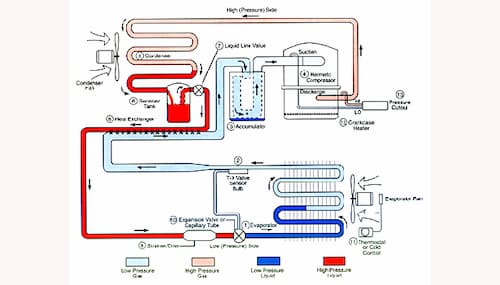
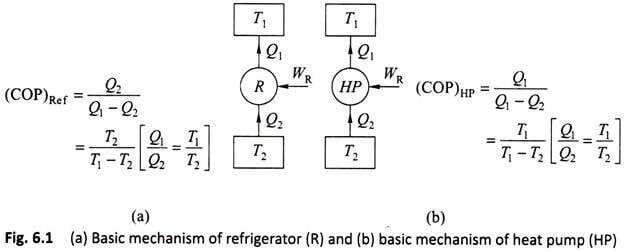
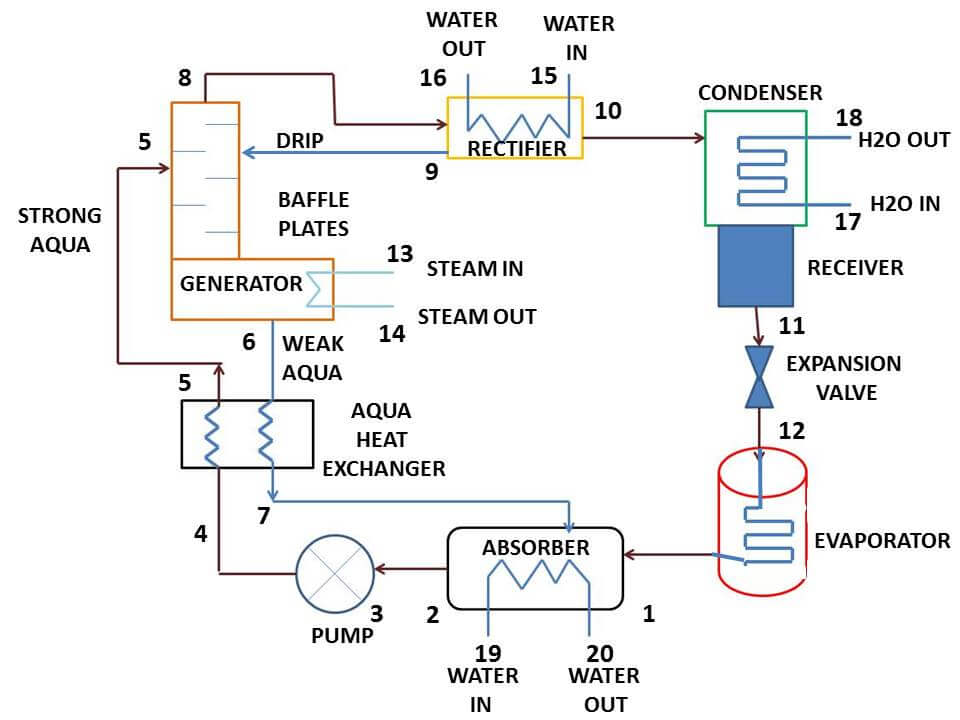
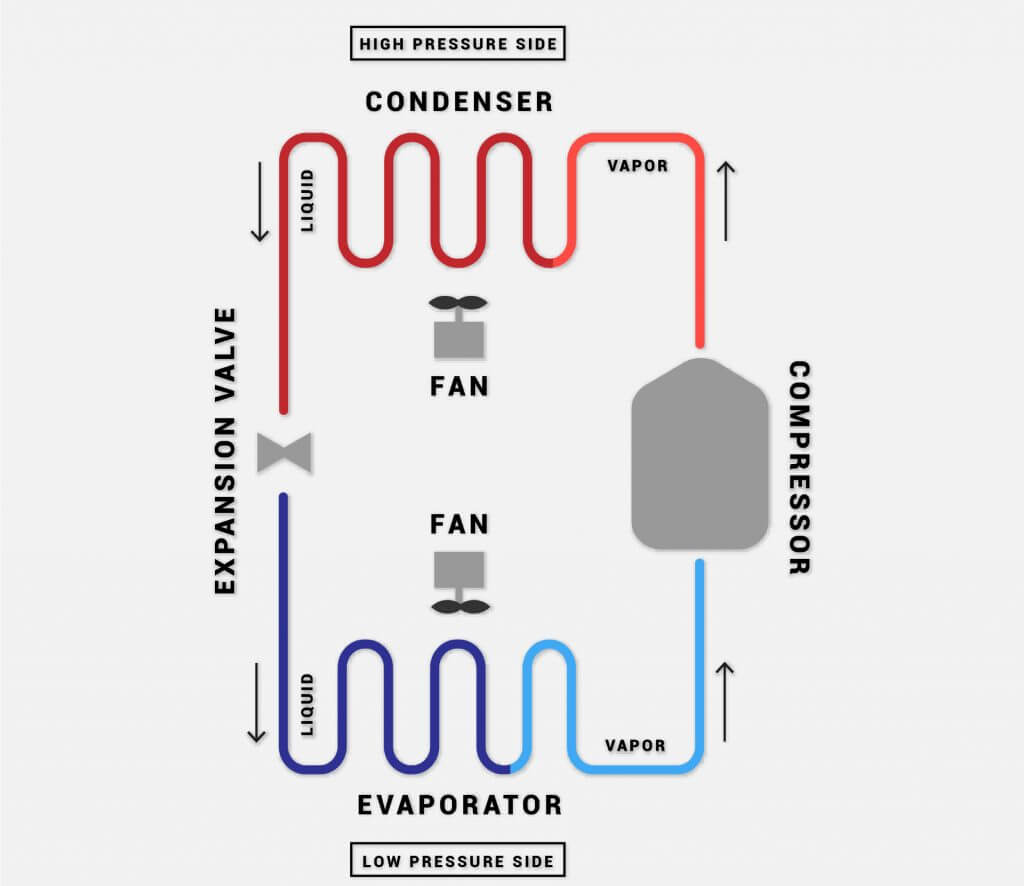
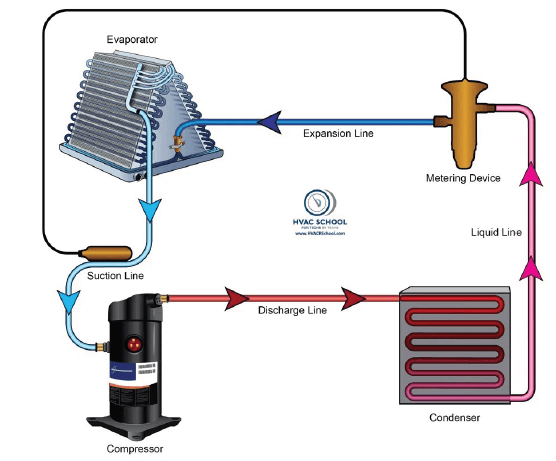

Leave a Reply